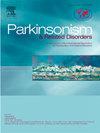Clinical feature and alpha-synuclein level of restless legs syndrome with leucine-rich repeat kinase 2 encoding gene mutation
IF 3.1
3区 医学
Q2 CLINICAL NEUROLOGY
引用次数: 0
Abstract
Introduction
Restless leg syndrome (RLS) has been reported associated with Parkinson's Disease (PD). However, it remained largely unknown of the mechanism underlying this association between RLS and PD.
Methods
199 idiopathic RLS and 114 PD were diagnosed and recruited by neurologists from Ruijin Hospital affiliated to Shanghai Jiao Tong University. And 273 health controls were recruited from community. Eight LRRK2 pathogenic variants were sequenced. Clinical data was collected including symptoms, comorbidities, family history, and iron level. ELISA was used to measure plasma level of α-synuclein.
Results
The G2385R variant was found significantly higher in PD group after Bonferroni correction (p = 0.018). Taking all LRRK2 mutations as one risk covariant, further logistic regression analysis showed a marginal association of LRRK2 with RLS (OR = 1.847, 95 %CI:1.022–3.337, p = 0.042) after adjusting age and gender. In terms of clinical feature, it was found that RLS-LRRK2 carriers usually reported a positive family history of neurological or psychiatric disorders including PD, RLS, dementia and depression (48.3 % vs 27.6 %)(p = 0.026) and a higher foot involvement of sensory symptoms (33.3 % vs 14.0 %)(p = 0.042). Plasma α-synuclein level in RLS (p = 0.021) and PD (p = 0.018) was both significantly increased compared to non-manifesting carriers.
Conclusion
Our study showed that LRRK2 mutation was associated with Chinese PD patients but only showed a possible trend of association with RLS. Positive neurological or psychiatric family history and foot discomfort in RLS were important features of indication of LRRK2 mutation in RLS. Plasma α-syn was increased in LRRK2-RLS as well as LRRK2-PD, indicating a possible association of RLS with PD in LRRK2 carriers.

富亮氨酸重复激酶2编码基因突变的不宁腿综合征临床特征及α -突触核蛋白水平
不宁腿综合征(RLS)已被报道与帕金森病(PD)相关。然而,RLS和PD之间的关联机制仍然是未知的。方法选取上海交通大学附属瑞金医院神经内科诊断的特发性RLS患者199例,PD患者114例。从社区招募了273名健康对照者。对8个LRRK2致病变异进行了测序。收集临床资料,包括症状、合并症、家族史和铁水平。ELISA法检测血浆α-突触核蛋白水平。结果经Bonferroni校正后,PD组G2385R变异显著升高(p = 0.018)。将所有LRRK2突变作为一个风险协变,进一步logistic回归分析显示,在调整年龄和性别后,LRRK2与RLS存在边际相关性(OR = 1.847, 95% CI:1.022 ~ 3.337, p = 0.042)。在临床特征方面,研究发现RLS- lrrk2携带者通常报告有神经或精神疾病家族史,包括PD、RLS、痴呆和抑郁症(48.3%比27.6%)(p = 0.026),并且有较高的足部感觉症状(33.3%比14.0%)(p = 0.042)。RLS患者血浆α-突触核蛋白水平(p = 0.021)和PD患者血浆α-突触核蛋白水平(p = 0.018)均显著高于非显性携带者。结论我们的研究显示LRRK2突变与中国PD患者相关,但仅表现出与RLS相关的可能趋势。神经或精神家族史阳性和足部不适是RLS患者LRRK2突变的重要特征。LRRK2-RLS和LRRK2-PD患者血浆α-syn升高,提示LRRK2携带者的RLS与PD可能存在关联。
本文章由计算机程序翻译,如有差异,请以英文原文为准。
求助全文
约1分钟内获得全文
求助全文
来源期刊

Parkinsonism & related disorders
医学-临床神经学
CiteScore
6.20
自引率
4.90%
发文量
292
审稿时长
39 days
期刊介绍:
Parkinsonism & Related Disorders publishes the results of basic and clinical research contributing to the understanding, diagnosis and treatment of all neurodegenerative syndromes in which Parkinsonism, Essential Tremor or related movement disorders may be a feature. Regular features will include: Review Articles, Point of View articles, Full-length Articles, Short Communications, Case Reports and Letter to the Editor.
 求助内容:
求助内容: 应助结果提醒方式:
应助结果提醒方式:


